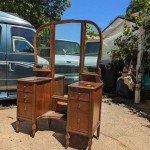How To Hang a Heavy Frameless Mirror On a Wall
Hanging a heavy frameless mirror presents unique challenges compared to framed artwork. The absence of a frame removes the usual hanging points and requires specialized hardware and a meticulous approach to ensure both safety and stability. This guide outlines the necessary steps and considerations for successfully hanging a heavy frameless mirror on your wall.
Assessing the Mirror and Wall
Before purchasing any hardware, carefully measure and weigh the mirror. Accurate measurements are crucial for selecting appropriate hardware capable of supporting the mirror’s weight. Equally important is assessing the wall type. Drywall requires different fasteners than concrete or brick. If unsure about the wall's construction, consult a professional contractor to avoid potential hazards. Knowing the wall type informs the choice of anchors and screws necessary for a secure installation.
Once the mirror and wall are assessed, determine the desired hanging height and mark the location on the wall. Using a level ensures the mirror hangs straight. Double-check the measurements and markings before proceeding to the next stage, as inaccuracies can lead to an unstable hanging.
Choosing the Right Hardware
Selecting the correct hardware is paramount for safely hanging a heavy frameless mirror. Several options are available, each suited to different weights and wall types. J-channels or Z-clips are popular choices, offering a secure grip on the mirror's edges. These clips are typically mounted to the wall and then the mirror is slid into place. For extremely heavy mirrors, consider using French cleats. These consist of two interlocking pieces, one mounted on the wall and the other on the back of the mirror. They provide a robust and stable hanging solution.
Adhesive options, such as mirror mastic, can be used in conjunction with mechanical fasteners for added security, particularly on smooth surfaces. However, relying solely on adhesive is not recommended for heavy mirrors as it can fail over time, posing a significant risk. Ensure the chosen hardware is rated to handle a weight significantly exceeding that of the mirror, providing a substantial safety margin.
When choosing screws and anchors, match them to the wall type and the weight of the mirror. Consult the hardware manufacturer's specifications for weight limits and recommended wall types. For drywall, consider using toggle bolts or molly bolts for heavy mirrors. Concrete or brick walls require masonry screws or anchors. Using inadequate fasteners can result in the mirror falling, causing damage and potential injury.
Installation Process
Begin by carefully marking the locations for the chosen hardware on the wall. Precision in this step is crucial for ensuring the mirror hangs level and secure. Use a level to verify the accuracy of the markings. If installing J-channels or Z-clips, ensure they are aligned correctly to receive the mirror. For French cleats, meticulously align the two halves to ensure a snug fit.
Once the hardware is securely mounted on the wall, carefully lift the mirror and position it onto the hardware. If using J-channels or Z-clips, slide the mirror into place, ensuring it sits firmly within the channels. For French cleats, interlock the two halves, ensuring a tight and secure connection. With heavier mirrors, having an assistant is highly recommended to prevent accidents and ensure proper alignment.
After the mirror is hung, gently test its stability by applying slight pressure in different areas. If any movement or instability is detected, re-evaluate the installation and ensure all hardware is correctly fastened. For added safety, consider applying a thin bead of clear silicone sealant along the bottom edge of the mirror where it meets the wall. This helps prevent moisture from seeping behind the mirror and provides additional stability.
Safety Precautions
Throughout the entire installation process, prioritize safety. Wear appropriate safety glasses to protect your eyes from dust and debris. If using power tools, familiarize yourself with their operation and follow the manufacturer's safety guidelines. When lifting the heavy mirror, use proper lifting techniques to avoid back injuries. If the mirror is exceptionally large or heavy, seek assistance from a professional installer.
Working with a partner is strongly recommended when handling heavy mirrors. One person can guide the mirror into place while the other secures the hardware. This collaborative approach minimizes the risk of dropping the mirror and ensures accurate placement. Having a stable work surface nearby to rest the mirror on while preparing the wall or the back of the mirror is also beneficial and can help prevent accidents.
Always prioritize safety when working with heavy objects and complex installations. If you are unsure about any aspect of the process, consult a professional. They possess the expertise and equipment to handle complex installations safely and efficiently. Taking the time to plan and execute the installation correctly ensures a secure and visually appealing result.

How To Install A Mirror Without Frame Merrypad

How To Hang A Frameless Mirror On Wall

How To Hang A Frameless Mirror On The Wall With Pictures

How To Install A Mirror Without Frame Merrypad
:strip_icc()/DesireeBurnsInteriors1-f76d25cad90041c88fbae4a7dc10aab4.jpg?strip=all)
2 Simple Ways To Hang A Frameless Mirror

How To Hang A Frameless Mirror June 2024 Your Guide Hanging

How To Hang A Large Wall Mirror Step By Tutorial

How To Hang A Hanging Mirror Without Accompanying Hardware
:strip_icc()/ScreenShot2022-04-28at1.12.19PM-e055476c70c6438585fa7c5cd531edcf.png?strip=all)
4 Easy Ways To Hang A Heavy Mirror

How To Hang A Frameless Mirror On The Wall With Pictures








